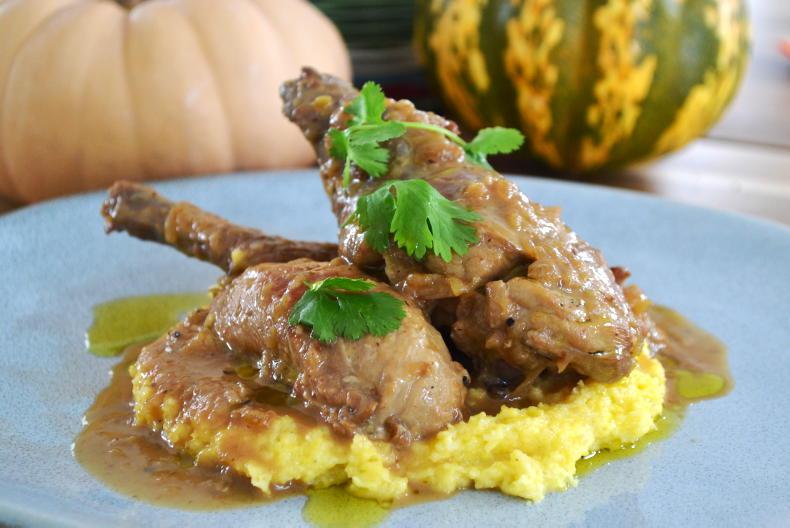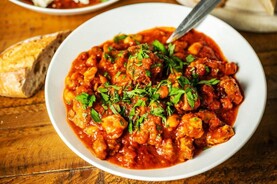I remember the first time I ever broke down a rabbit. It was in my butchery class while I was attending culinary school. Our instructor was a big, burly Austrian man who would eat raw chicken just to see our reaction. He told us terrifying stories of what happens when a human gets mad cow disease. He regaled us with stories of his childhood on a farm, where they would cure their own pork among other endeavours (from a food safety perspective, it was much more dangerous back then to cure your own pork, he always assured us).
So of course, when we were due to break down the carcase of a rabbit, he just had to tell us that their physiological make up is very, very similar to that of a cat's. My good friend, who had both cats and a rabbit as pets, immediately got up and left the room. I still can't pet my cat without thinking about that class!
I understand why some people are turned off by rabbit - they are very cute and fluffy and are often kept as pets. But they can equally be delicious, ethically farmed and a low-impact meat, from a carbon perspective. A true Spanish paella, it is said, should always include rabbit. Braised rabbit is a common dish in certain parts of Europe. We still trap rabbits in my part of Canada - their fur can be useful and their meat is flavoursome.
I make sure to use every part of the animal. For the braising liquid in this recipe, I made a quick stock from all of the bones of the rabbit (just boil for one to two hours with some carrot, onion, celery and herbs).
A rabbit can be broken down into two legs, two front arms and two main tenderloins on either side of their spine. In this recipe (see video), I used a sharp knife to separate the loins from the body, but if you have a large butcher's cleaver, you can leave them on the bone.
I bought this rabbit from The Village Butcher in Dublin - they deliver nationwide, so you can purchase online. Braising is a great way to cook rabbit because its legs can be on the tougher side. Braising is a combination wet and dry cooking method. You start off dry by searing the meat in a hot pan and then you add braising liquid and finish by slow cooking. It's one of my favourite ways to cook in the autumn and winter months.
A sharp knife - preferably a boning knife, meant for butchery - is the key to success when it comes to breaking down a carcase of this size.
Also, just to note - if you really don't want to cook rabbit, this recipe also works nicely with chicken!
Easy Braised Rabbit with Polenta
Serves four
Ingredients
1 whole rabbit, broken down into front legs, back legs and loin (see video)
2 tbsp rapeseed or olive oil
Freshly ground black pepper
Sea salt
1 tbsp butter
1 onion, finely sliced
1 shallot, finely sliced
2 cloves garlic, crushed
200ml wine
1l rabbit stock (or chicken stock)
More salt and pepper, to taste (optional)
For the polenta:
500ml hot chicken stock
500ml full fat milk
200g polenta
2 tbsp butter
50g finely grated Parmesan cheese
Salt and pepper, to taste
Directions
1 Break down the rabbit. First, remove the front legs by slicing directly through the joint (where the arm meets the body). Then, remove the back legs. Start slicing close to the body, then - using your hands - snap the thigh bone away from the body. Where the bone snapped, you will be able to slice through with a knife. When the back legs are removed, use your knife to remove the 'flappy' bits of skin on either side of the rabbit. Separate the ribs from the loin area (see video) and then either chop the loin in half using a meat cleaver or carefully separate the meat from either side of the spine.
2 In a very hot pan, add the oil. Season the rabbit pieces with salt and pepper, then place them in the hot pan to sear. Sear for two to three minutes per side, until golden brown and slightly crisp. Remove from the heat and set aside.
3 Add the butter and turn the heat down to medium. Add the onion, shallot and garlic and cook for five to 10 minutes, until lightly golden and cooked through. Place the rabbit back into the pan and add the wine. Cook to reduce the wine by half and then add the stock.
4 Bring to a simmer and gently cook the rabbit, covered, for 2.5 to three hours, until completely tender. After two hours, remove the lid and let the sauce reduce and thicken. Do not add any salt until the very end as the sauce will intensify in flavour as it reduces.
5 Make the polenta - bring the chicken stock and milk to a boil and slowly add the polenta while whisking constantly.
6 The polenta will thicken as you are whisking. Keep whisking until it is thick and well combined. Switch from a whisk to a spatula at this stage.
7 Add the butter and cheese and gently fold them i to the polenta with the spatula. Season to taste.
8 Add some polenta to a warmed plate and top with the braised rabbit. The rabbit can be made two days ahead of time and kept in the fridge, but the polenta needs to be made directly before serving.
Read more
Feeling chilly? Try this comforting tomato soup with cheesy sourdough croutons
Easy school-night dinner the whole family will love
I remember the first time I ever broke down a rabbit. It was in my butchery class while I was attending culinary school. Our instructor was a big, burly Austrian man who would eat raw chicken just to see our reaction. He told us terrifying stories of what happens when a human gets mad cow disease. He regaled us with stories of his childhood on a farm, where they would cure their own pork among other endeavours (from a food safety perspective, it was much more dangerous back then to cure your own pork, he always assured us).
So of course, when we were due to break down the carcase of a rabbit, he just had to tell us that their physiological make up is very, very similar to that of a cat's. My good friend, who had both cats and a rabbit as pets, immediately got up and left the room. I still can't pet my cat without thinking about that class!
I understand why some people are turned off by rabbit - they are very cute and fluffy and are often kept as pets. But they can equally be delicious, ethically farmed and a low-impact meat, from a carbon perspective. A true Spanish paella, it is said, should always include rabbit. Braised rabbit is a common dish in certain parts of Europe. We still trap rabbits in my part of Canada - their fur can be useful and their meat is flavoursome.
I make sure to use every part of the animal. For the braising liquid in this recipe, I made a quick stock from all of the bones of the rabbit (just boil for one to two hours with some carrot, onion, celery and herbs).
A rabbit can be broken down into two legs, two front arms and two main tenderloins on either side of their spine. In this recipe (see video), I used a sharp knife to separate the loins from the body, but if you have a large butcher's cleaver, you can leave them on the bone.
I bought this rabbit from The Village Butcher in Dublin - they deliver nationwide, so you can purchase online. Braising is a great way to cook rabbit because its legs can be on the tougher side. Braising is a combination wet and dry cooking method. You start off dry by searing the meat in a hot pan and then you add braising liquid and finish by slow cooking. It's one of my favourite ways to cook in the autumn and winter months.
A sharp knife - preferably a boning knife, meant for butchery - is the key to success when it comes to breaking down a carcase of this size.
Also, just to note - if you really don't want to cook rabbit, this recipe also works nicely with chicken!
Easy Braised Rabbit with Polenta
Serves four
Ingredients
1 whole rabbit, broken down into front legs, back legs and loin (see video)
2 tbsp rapeseed or olive oil
Freshly ground black pepper
Sea salt
1 tbsp butter
1 onion, finely sliced
1 shallot, finely sliced
2 cloves garlic, crushed
200ml wine
1l rabbit stock (or chicken stock)
More salt and pepper, to taste (optional)
For the polenta:
500ml hot chicken stock
500ml full fat milk
200g polenta
2 tbsp butter
50g finely grated Parmesan cheese
Salt and pepper, to taste
Directions
1 Break down the rabbit. First, remove the front legs by slicing directly through the joint (where the arm meets the body). Then, remove the back legs. Start slicing close to the body, then - using your hands - snap the thigh bone away from the body. Where the bone snapped, you will be able to slice through with a knife. When the back legs are removed, use your knife to remove the 'flappy' bits of skin on either side of the rabbit. Separate the ribs from the loin area (see video) and then either chop the loin in half using a meat cleaver or carefully separate the meat from either side of the spine.
2 In a very hot pan, add the oil. Season the rabbit pieces with salt and pepper, then place them in the hot pan to sear. Sear for two to three minutes per side, until golden brown and slightly crisp. Remove from the heat and set aside.
3 Add the butter and turn the heat down to medium. Add the onion, shallot and garlic and cook for five to 10 minutes, until lightly golden and cooked through. Place the rabbit back into the pan and add the wine. Cook to reduce the wine by half and then add the stock.
4 Bring to a simmer and gently cook the rabbit, covered, for 2.5 to three hours, until completely tender. After two hours, remove the lid and let the sauce reduce and thicken. Do not add any salt until the very end as the sauce will intensify in flavour as it reduces.
5 Make the polenta - bring the chicken stock and milk to a boil and slowly add the polenta while whisking constantly.
6 The polenta will thicken as you are whisking. Keep whisking until it is thick and well combined. Switch from a whisk to a spatula at this stage.
7 Add the butter and cheese and gently fold them i to the polenta with the spatula. Season to taste.
8 Add some polenta to a warmed plate and top with the braised rabbit. The rabbit can be made two days ahead of time and kept in the fridge, but the polenta needs to be made directly before serving.
Read more
Feeling chilly? Try this comforting tomato soup with cheesy sourdough croutons
Easy school-night dinner the whole family will love






 This is a subscriber-only article
This is a subscriber-only article











SHARING OPTIONS: